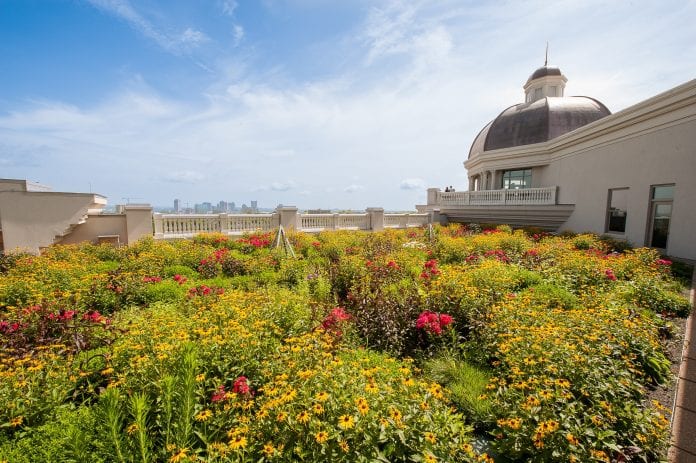Belmont becomes first university in Tennessee, first new construction in Nashville to achieve platinum LEED® status
Ten months after a successful opening, the Wedgewood Academic Center was recently awarded prestigious LEED Platinum® certification by the U.S. Green Building Council (USGBC), making Belmont the first University in Tennessee and the first LEED for New Construction project in Nashville to achieve that level, the highest in the LEED ratings system.
The 186,000 square foot Wedgewood Academic Center sits above a five-level underground parking garage and represents Belmont’s largest building to date. The facility houses more than 50 undergraduate programs from three different colleges as well as 20 state-of-the-art science labs, numerous classrooms and offices, two food service venues, multiple green roofs and a chapel.
David Minnigan, a principal with architectural firm Earl Swensson Associates (ESa), noted that the platinum certification is even more significant considering the challenges such a building presents in terms of its large size, style (traditional versus modern) and contents. “With such classical architecture, it is not always appropriate to use contemporary techniques—like some types of green screens or sun shades—that are commonly utilized on many LEED-certified new construction projects. Plus, a facility that’s in use by college students 18 hours a day and incorporates science laboratory facilities can make energy efficiency difficult. But Belmont is committed to quality construction, and Bob and Judy Fisher are champions of sustainable design. They are passionately dedicated to common-sense sustainability, so we were excited to partner with them to help achieve their goals for this project.”
Belmont President Dr. Bob Fisher, who participated as a college student in the first Earth Day celebration in 1970, works diligently to balance cost effective construction with environmentally-friendly features, examining every detail of each new construction project. “Universities should be at the forefront of issues impacting society. And my son Rob, who is an environmental consultant, frequently reminds me that sustainability and conservation are critical topics facing us today and facing the future generations we’re educating on this campus. It’s imperative that we model a strong commitment to managing resources, as Belmont’s done with its Conservation Covenant, recognizing that prioritizing ‘green’ initiatives reflects good stewardship and offers long-term benefits to our operations, the environment and our community’s health and satisfaction.”
LEED®, which stands for Leadership in Energy and Environmental Design, is the preeminent program for the design, construction, maintenance and operations of high-performance green buildings. To achieve LEED certification, building projects satisfy prerequisites and earn points to achieve different levels of certification, with platinum representing the highest possible level. Points are accumulated in a number of categories, including the sustainability of the site itself, water efficiency, energy conservation, materials and resources, indoor environmental quality and innovation in design.
A few highlights of the sustainable initiatives that are reflected in the Wedgewood Academic Center as outlined in the LEED report include:
- Over 30,000 square feet of site area was restored or protected
- 73 percent of the area within the LEED project boundary is vegetated open space
- Combination of vegetated roof (over 18,600 square feet) and highly reflective roof (over 23,800 square feet) will result in significant energy savings, reduced heat island effect and effective storm water runoff treatment
- 100 percent reduction in potable water usage and 55 percent reduction in total water usage were achieved through use of groundwater for irrigation
- 41 percent reduction in water usage in flush & flow fixtures (saving approximately 200 kGal of water annually)
- Energy usage was reduced by 38 percent over a baseline building due to several factors that include space conditioning provided by chilled beams, water source heat pumps, and variable refrigerant flow (VRF) heat pumps
- Energy use reduction results in approximately $155,000 in annual energy savings for the University
- 8 percent of construction waste was diverted from landfills (953 tons total)
- 44 percent of all materials used on-site (by cost) were manufactured and extracted/harvested/recovered within 500 miles of the project site.
A complete scorecard for the Wedgewood Academic Center’s LEED certification can be found here.



